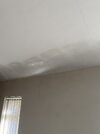Hi everyone, hoping someone would provide some guidance if possible. In my house one of the bedrooms gets a bad damp problem from condensation, this looks to be the worst I’ve seen it. It was built in the 1950’s, there has been insulation laid in the attic, only on the ceiling level which I think makes it a cold roof. There is insulation laid on the flat bit of the ceiling boards, but I don’t think there is any insulation on the dip to the top of the blockwork wall. Do you think this could be a cold bridging problem? Is it a case of adding some insulation to this dip? All advice would be hugely welcome, I think this could be the problem but wondering if it could be anything else?
Thank you so much in advance
Thank you so much in advance





